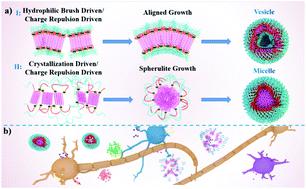当前位置:
X-MOL 学术
›
J. Mater. Chem. B
›
论文详情
Our official English website, www.x-mol.net, welcomes your feedback! (Note: you will need to create a separate account there.)
Hydrophilic polymer driven crystallization self-assembly: an inflammatory multi-drug combination nanosystem against Alzheimer’s disease
Journal of Materials Chemistry B ( IF 7 ) Pub Date : 2021-08-21 , DOI: 10.1039/d1tb00762a Haodong Hu 1 , Jinna Wang 1 , Jian Ren 1 , Xinpo Li 1 , Bo Zhang 1 , Zhengang Lv 2 , Fengying Dai 1
Journal of Materials Chemistry B ( IF 7 ) Pub Date : 2021-08-21 , DOI: 10.1039/d1tb00762a Haodong Hu 1 , Jinna Wang 1 , Jian Ren 1 , Xinpo Li 1 , Bo Zhang 1 , Zhengang Lv 2 , Fengying Dai 1
Affiliation

|
The hydrophobic polymer driven crystallization of self-assembled micelles is usually sufficient for their purposes in materials chemistry studies. However, with the state of smart drug delivery research, micelles alone are not enough. The principles of the self assembly driven by hydrophilic dextran brushes together with charged poly(3-acrylamidophenyl boronic acid) (PPBA) are uncovered in this study. A series of poly(ε-caprolactone)-block-poly(3-acrylamidophenyl boronic acid)-dextran (PCL-b-PPBA-Dex) micelles and vesicles are investigated as potential Alzheimer’s disease (AD) treatments. Three inflammatory microenvironment responsive micelles, including celecoxib drug-loaded micelles (CEL), ibuprofen drug-loaded micelles (IBU) and telmisartan drug-loaded micelles (TEL), are developed. In vivo, CEL/IBU (mixture of CEL and IBU) and CEL/TEL (mixture of CEL and TEL) suppress the activation of glia and reduce the levels of inflammatory mediators through eliminating cyclooxygenase 2 (COX-2) signals. The CEL/TEL combination nanosystem is better at correcting neuroinflammation and improving the spatial memory ability of a senescence-accelerated mouse prone 8 model (SAMP8). We consider that the inflammation responsive combination nanosystem provides a new potential treatment for AD clinical patients.
中文翻译:

亲水性聚合物驱动的结晶自组装:一种针对阿尔茨海默病的炎症性多药组合纳米系统
自组装胶束的疏水聚合物驱动结晶通常足以满足其在材料化学研究中的目的。然而,随着智能给药研究的现状,仅靠胶束是不够的。本研究揭示了由亲水性葡聚糖刷与带电聚 (3-丙烯酰胺基苯基硼酸) (PPBA) 驱动的自组装原理。一系列聚(ε-己内酯)-嵌段-聚(3-丙烯酰胺基苯基硼酸)-葡聚糖(PCL- b-PPBA-Dex) 胶束和囊泡被研究为潜在的阿尔茨海默病 (AD) 治疗。开发了三种炎症微环境反应胶束,包括塞来昔布载药胶束(CEL)、布洛芬载药胶束(IBU)和替米沙坦载药胶束(TEL)。在体内,CEL/IBU(CEL 和 IBU 的混合物)和 CEL/TEL(CEL 和 TEL 的混合物)通过消除环氧合酶 2 (COX-2) 信号来抑制神经胶质细胞的活化并降低炎症介质的水平。CEL/TEL 组合纳米系统在纠正神经炎症和提高衰老加速小鼠俯卧 8 模型 (SAMP8) 的空间记忆能力方面效果更好。我们认为炎症反应性组合纳米系统为AD临床患者提供了一种新的潜在治疗方法。
更新日期:2021-09-10
中文翻译:

亲水性聚合物驱动的结晶自组装:一种针对阿尔茨海默病的炎症性多药组合纳米系统
自组装胶束的疏水聚合物驱动结晶通常足以满足其在材料化学研究中的目的。然而,随着智能给药研究的现状,仅靠胶束是不够的。本研究揭示了由亲水性葡聚糖刷与带电聚 (3-丙烯酰胺基苯基硼酸) (PPBA) 驱动的自组装原理。一系列聚(ε-己内酯)-嵌段-聚(3-丙烯酰胺基苯基硼酸)-葡聚糖(PCL- b-PPBA-Dex) 胶束和囊泡被研究为潜在的阿尔茨海默病 (AD) 治疗。开发了三种炎症微环境反应胶束,包括塞来昔布载药胶束(CEL)、布洛芬载药胶束(IBU)和替米沙坦载药胶束(TEL)。在体内,CEL/IBU(CEL 和 IBU 的混合物)和 CEL/TEL(CEL 和 TEL 的混合物)通过消除环氧合酶 2 (COX-2) 信号来抑制神经胶质细胞的活化并降低炎症介质的水平。CEL/TEL 组合纳米系统在纠正神经炎症和提高衰老加速小鼠俯卧 8 模型 (SAMP8) 的空间记忆能力方面效果更好。我们认为炎症反应性组合纳米系统为AD临床患者提供了一种新的潜在治疗方法。



























 京公网安备 11010802027423号
京公网安备 11010802027423号